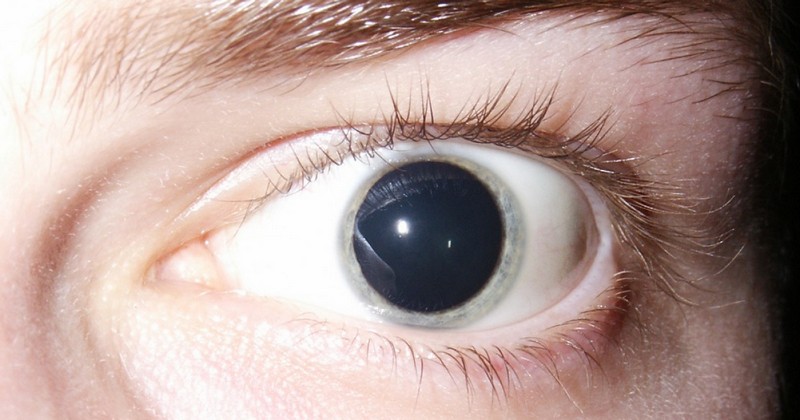Mydriasis (extreme pupil dilation): symptoms, causes and treatment

This alteration in the functioning of the eye causes the pupil to dilate uncontrollably.
Mydriasis is the phenomenon of pupil widening (pupil dilation), which can be caused by factors both internal and external to the body. It is the opposite of miosis (reduction of pupil size) and is generally a physiological response to light and brightness.
However, if it remains dilated even without the light stimulus, then it is certainly no longer a physiological response and could indicate the presence of disease or pathological habits. Below we explain how pupils work and what factors can cause them to which factors can provoke their dilation, mydriasis..
How do pupils work?
The pupils are the black circles in the center of our eyes whose function is to pass light to the retina to form images. They are surrounded by the iris and the cornea.and are composed of an opening that widens or contracts to allow light to pass through. Sometimes it widens to allow better vision, and sometimes it contracts to protect us from excessively luminous stimuli.
However, pupils are activated as an automatic response to different factors (not only light), and the system in charge of controlling their activity is the autonomic nervous system, itself divided into the sympathetic nervous system and the parasympathetic nervous system.
When the reason for the widening of the pupil is not only related to our physiology is not only related to our physiology and our visionIn this case, mydriasis may be an indicator of the existence of a pathological condition, or it may indicate that a substance that alters the nervous system has been recently consumed.
Types and causes of mydriasis
Mydriasis is a natural and quite common phenomenon, which helps us to perceive light properly when it is presented to us in large amounts. Sometimes, however, mydriasis is not caused by exposure to light. is not caused by exposure to light but by other elements that also affect our organism..
Among the factors that change the size of the pupil causing mydriasis are some diseases and the use of drugs. Below we will present
Pharmacological causes
As its name says, pharmacological causes of mydriasis are those related to the use of drugs. For example, the use of anticholinergic drugs increases dilation.These are substances that block the transmission of some chemicals to the eyes.
Another pharmacological cause is the recreational use of psychotropic substances, such as cocaine, ecstasy, hallucinogens, methamphetamines or THC. This is because these substances affect the serotonin receptors in the brain (depending on the type of drug, they increase or decrease their secretion), which generates dilation.
Medical causes
Medical causes are those that are related to a surgical related to a surgical intervention that has among its effects the dilation of the pupils. For example, surgeries to treat brain trauma cause mydriasis because they increase the pressure on the skull, which affects the eyes.
On the other hand, eye surgeries sometimes significantly damage the nerves that control the pupils or iris. As a result, pupils can adopt different ways of reacting to light.
Physiological and neurophysiological causes
Physiological and neurophysiological causes of mydriasis are those that are related to our Biological or neuroanatomical functions. Specifically, they are the causes related to how our brain and other related systems function.
The presence of high levels of oxytocin can lead to a temporary picture of mydriasis. This is because oxytocin is the substance that is released when we exercise and when we interact with people, both physically and socially. It is also the substance that is released during childbirth.
Likewise, mydriasis is usually present during cranial nerve neuropathies, which are gradual damage to the nerves surrounding the eye. This affects the oculomotor system and the nerves responsible for the pupils to widen or contract.
For example, parasympathetic nerve palsies. Other related causes include strokes, head injuries, traumatic brain injuryCranioencephalic trauma, cerebral hernias or epilepsy.
Finally, one of the conditions that include mydriasis is Benign Unilateral Episode of Mydriasis (BEUM), which is a temporary condition of pupil dilation, usually accompanied by headaches and eye pain, sensitivity to light and blurred vision. It usually occurs for example during some migraine episodes.
Treatment and what to do
In the case of mydriasis, it is important to be attentive if the pupil dilation is maintained for a prolonged period of time (if the light stimulus has disappeared or if enough time has passed to adapt to it). In these cases it is important to consult a medical specialist..
As a treatment it is advisable to avoid direct exposure to the sunas well as to avoid driving. It is also advisable to wear dark glasses and avoid reading texts at a short distance. Doing the opposite to all these recommendations may cause mydriasis to remain and significantly affect our vision.
On the other hand, if it is an indicator of a pathological condition, the specialist may recommend surgical treatment.
(Updated at Apr 13 / 2024)